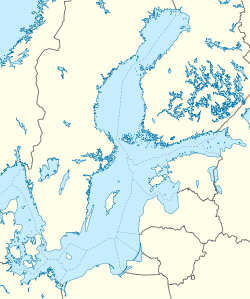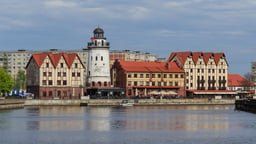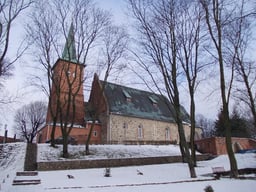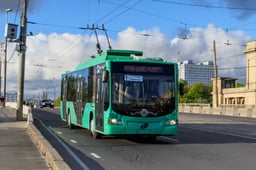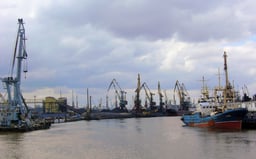Kaliningrad
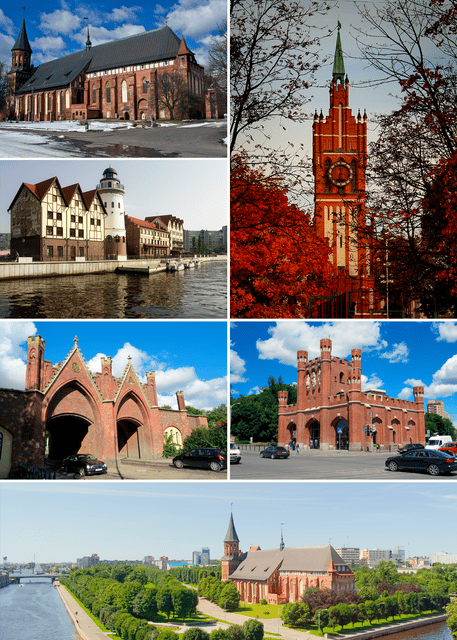
Kaliningrad

Kaliningrad Калининград | |
|---|---|
City[1] | |
| Anthem: none[2] | |
Location of Kaliningrad | |
| Coordinates:54°42′01″N 20°27′11″E [65] | |
| Country | Russia |
| Federal subject | Kaliningrad Oblast[1] |
| Founded | 1 September 1255[3] |
| Government | |
| • Body | City Council of Deputies[4] |
| • Head[4] | Alexey Silanov[5] |
| Area | |
| • Total | 223.03 km2(86.11 sq mi) |
| Elevation | 5 m (16 ft) |
| Population (2010 Census)[6] | |
| • Total | 431,402 |
| • Estimate (2018)[7] | 475,056 (+10.1%) |
| • Rank | 40th in 2010 |
| • Density | 1,900/km2(5,000/sq mi) |
Administrative status | |
| • Subordinated to | city of oblast significance of Kaliningrad[1] |
| • Capital of | Kaliningrad Oblast[8], city of oblast significance of Kaliningrad[1] |
Municipal status | |
| • Urban okrug | Kaliningrad Urban Okrug[9] |
| • Capital of | Kaliningrad Urban Okrug[9] |
| Time zone | UTC+2 (MSK–1 [10]) |
| Postal code(s)[11] | 236001 - 236999 |
| Dialing code(s) | +7 4012 |
| OKTMO ID | 27701000001 |
| City Day | 4 July; observed on the first Saturday of July |
| Twin towns | Klaipėda, Zeitz, Aalborg, Odense, Bremerhaven, Kiel, Rostock, Lichtenberg, Southampton, Cork, Kaunas, Panevėžys, Šiauliai, Vilnius, Groningen, Białystok, Gdańsk, Elbląg, Łódź, Olsztyn, Racibórz, Toruń, Zabrze, Zwolle, Mexico City, Malmö Municipality, Norfolk, Burlöv Municipality, Kalmar Municipality, Omsk, Brest, Cagliari, Cherbourg-Octeville, Dalian, Yerevan, Forlì, Gomel, Guyuan, Hamburg, Grodno, Kętrzyn County, Kherson, Krasnoyarsk, Minsk, Potsdam, Samara, Severodvinsk, Turku, Yaroslavl, Baranavichy, Kalmar, Panevėžys City Municipality, Patras |
| Website | www.klgd.ru [66] |
Kaliningrad (Russian: Калининград, IPA: [kəlʲɪnʲɪnˈɡrat], historically German: Königsberg, Polish: Królewiec[12], Lithuanian: Karaliaučius) is the largest city and the administrative centre of Kaliningrad Oblast, a Russian exclave on the Baltic Sea. At the 2010 Census, Kaliningrad's population was 431,902.[6]
Kaliningrad has a rich history and its unique geopolitical location makes it a place like no other in Europe. Squeezed between two European countries, both now in the European Union – Poland and Lithuania – it was of the utmost strategic importance during the Cold War. During this time, the Soviets built a completely new city with few historic links to the old city, which they saw as a symbol of German imperialism. Much of the historic substance remains though, and there are several districts and a few monuments from pre-war times.
Kaliningrad Калининград | |
|---|---|
City[1] | |
| Anthem: none[2] | |
Location of Kaliningrad | |
| Coordinates:54°42′01″N 20°27′11″E [65] | |
| Country | Russia |
| Federal subject | Kaliningrad Oblast[1] |
| Founded | 1 September 1255[3] |
| Government | |
| • Body | City Council of Deputies[4] |
| • Head[4] | Alexey Silanov[5] |
| Area | |
| • Total | 223.03 km2(86.11 sq mi) |
| Elevation | 5 m (16 ft) |
| Population (2010 Census)[6] | |
| • Total | 431,402 |
| • Estimate (2018)[7] | 475,056 (+10.1%) |
| • Rank | 40th in 2010 |
| • Density | 1,900/km2(5,000/sq mi) |
Administrative status | |
| • Subordinated to | city of oblast significance of Kaliningrad[1] |
| • Capital of | Kaliningrad Oblast[8], city of oblast significance of Kaliningrad[1] |
Municipal status | |
| • Urban okrug | Kaliningrad Urban Okrug[9] |
| • Capital of | Kaliningrad Urban Okrug[9] |
| Time zone | UTC+2 (MSK–1 [10]) |
| Postal code(s)[11] | 236001 - 236999 |
| Dialing code(s) | +7 4012 |
| OKTMO ID | 27701000001 |
| City Day | 4 July; observed on the first Saturday of July |
| Twin towns | Klaipėda, Zeitz, Aalborg, Odense, Bremerhaven, Kiel, Rostock, Lichtenberg, Southampton, Cork, Kaunas, Panevėžys, Šiauliai, Vilnius, Groningen, Białystok, Gdańsk, Elbląg, Łódź, Olsztyn, Racibórz, Toruń, Zabrze, Zwolle, Mexico City, Malmö Municipality, Norfolk, Burlöv Municipality, Kalmar Municipality, Omsk, Brest, Cagliari, Cherbourg-Octeville, Dalian, Yerevan, Forlì, Gomel, Guyuan, Hamburg, Grodno, Kętrzyn County, Kherson, Krasnoyarsk, Minsk, Potsdam, Samara, Severodvinsk, Turku, Yaroslavl, Baranavichy, Kalmar, Panevėžys City Municipality, Patras |
| Website | www.klgd.ru [66] |
History
The history of the city may be divided into three clearly different periods: the Old Prussian settlement known as Twangste before 1255, German city of Königsberg from 1255 to 1945 and a Russian city from 1945. Since then it is inhabited by ethnic Russians and was renamed "Kaliningrad" in 1946 after Soviet leader Mikhail Kalinin.
Twangste

Old Prussian clans in the 13th century (Sambia - orange)
Königsberg was preceded by a Sambian (Old Prussian tribe) fort called Twangste (spelled also as Tuwangste or Tvankste), meaning Oak Forest.[13] During the conquest of the Sambians by the Teutonic Knights in 1255, Twangste was destroyed and replaced with a new fortress named Königsberg in the honour of Bohemian king Ottokar II. The declining Old Prussian culture finally became extinct around the 17th century, after the surviving Old Prussians were integrated through assimilation.
Königsberg
The settlement on the site of present day Kaliningrad was founded as a military fortress in 1255 after the Prussian Crusade by the Teutonic Knights against Baltic Prussians. The new settlement was named in honour of the Bohemian King Ottokar II. The crusade was followed by immigrant settlers from Germany and other regions of Western Europe. The city and surrounding area became predominantly German, with Polish, Lithuanian and Latvian minorities.
After the secularization of the Teutonic Order in 1525, Königsberg became the capital of the Duchy of Prussia, a fiefdom of the Polish king. As a symbol of its dependence, the black Prussian eagle had a crown thrust around its neck bearing the letter "S" from the Latinised name of the king, "Sigismundus". In 1618 the Duchy of Prussia passed under the control of the Electors of Brandenburg and in 1657, it became independent.
In the ensuing decades the city, now part of the German Empire continued to flourish and many iconic landmarks of Königsberg were built. The city had around 370,000 inhabitants and was a cultural and administrative center of Prussia and the German Empire. Immanuel Kant and E. T. A. Hoffmann, the notable sons of the city, were born during this time.
World War II
In World War II the city of Königsberg was heavily damaged by a British bombing attack in 1944 and the massive Soviet siege in spring 1945. At the end of World War II in 1945, the city became part of the Soviet Union (as part of the Russian SFSR).
Soviet Union
At the Potsdam Conference in 1945 the Allies agreed on the Soviet annexation pending the final determination of territorial questions at the peace settlement:
The Conference has agreed in principle to the proposal of the Soviet Government concerning the ultimate transfer to the Soviet Union of the City of Koenigsberg and the area adjacent to it as described above subject to expert examination of the actual frontier.[14]
The U.S. President Harry Truman and the British Prime Minister Clement Attlee declared that they would support the proposal of the Conference at the forthcoming peace settlement.[15]
Historical affiliations Old Prussians (until 1255) Teutonic Order 1255–1466 Kingdom of Poland 1454-1455 Teutonic Order 1466–1525 (fief of Poland) Duchy of Prussia 1525–1657 (fief of Poland) Duchy of Prussia 1657–1701 Kingdom of Prussia 1701–1758 Russian Empire 1758–1764 Kingdom of Prussia 1764–1871 German Empire 1871–1918 Weimar Germany 1918–1933 Nazi Germany 1933–1945 Soviet Union 1945–1991 Russia 1991–present
On 4 July 1946 the Soviet authorities renamed Königsberg to Kaliningrad[16] following the death on 3 June 1946 of the Chairman of the Presidium of the Supreme Soviet (titular head of state) of the USSR, Mikhail Kalinin, one of the original Bolsheviks. The survivors of the German population were forcibly expelled in 1946–1949, and the city was repopulated with Soviet citizens. The city's language of administration was changed from German to Russian.
The city was rebuilt, and as the westernmost territory of the USSR, the Kaliningrad Oblast became a strategically important area during the Cold War. The Soviet Baltic Fleet was headquartered in the city in the 1950s. Because of its strategic importance, Kaliningrad Oblast was closed to foreign visitors.
Russia
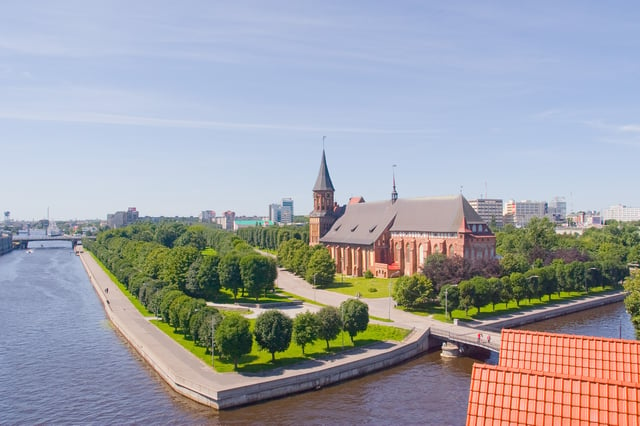
Kneiphof island with cathedral
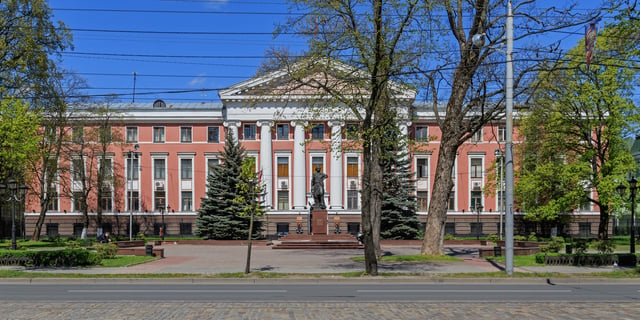
Baltic Fleet HQ (ex-postal admn. bldg.)
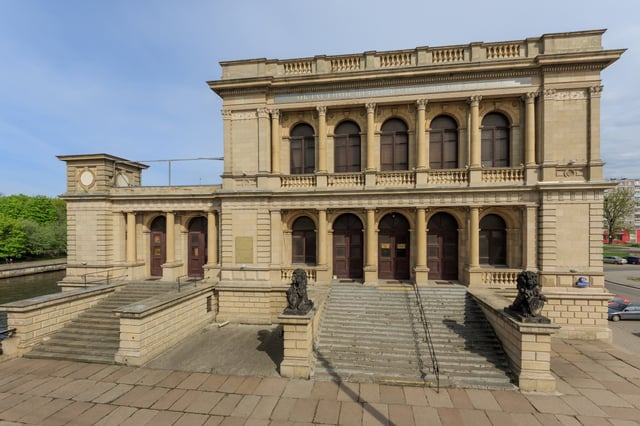
Former Königsberg Stock Exchange
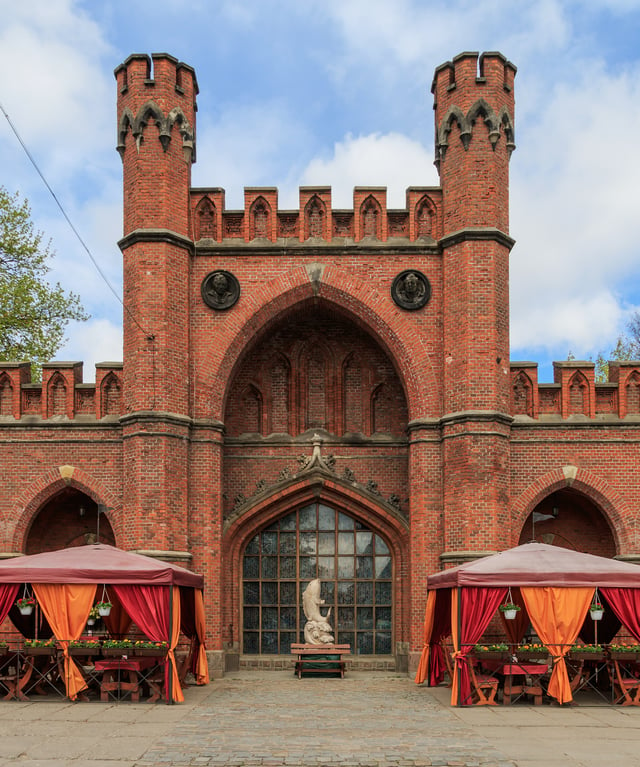
Rossgarten Gate, now a restaurant
The town of Baltiysk, just outside Kaliningrad, is the only Russian Baltic Sea port said to be "ice-free" all year round, and the region hence plays an important role in maintenance of the Baltic Fleet.
Due to the collapse of the Soviet Union in 1991, the Kaliningrad Oblast became an exclave, geographically separated from the rest of Russia. This isolation from the rest of Russia became even more pronounced politically when Poland and Lithuania became members of NATO and subsequently the European Union in 2004. All military and civilian land links between the region and the rest of Russia have to pass through members of NATO and the EU. Special travel arrangements for the territory's inhabitants have been made through the Facilitated Transit Document (FTD) and Facilitated Rail Transit Document (FRTD).
While in the 1990s many Soviet-era city names commemorating Communist leaders were changed (e.g. Leningrad reverting to Saint Petersburg), Kaliningrad remains named as it was.
Since the early 1990s, the Kaliningrad oblast has been a Free Economic Zone (FEZ Yantar). In 2005 the city marked 750 years of existence as Königsberg/Kaliningrad.[19] In July 2007, Russian First Deputy Prime Minister Sergei Ivanov declared that if US-controlled missile defense systems were deployed in Poland, then nuclear weapons might be deployed in Kaliningrad. On November 5, 2008, Russian leader Dmitry Medvedev said that installing missiles in Kaliningrad was almost a certainty.[20] These plans were suspended, however, in January 2009.[21]
But during late 2011, a long range Voronezh radar was commissioned to monitor missile launches within about 6,000 kilometres (3,728 miles). It is situated in the settlement of Pionersky (formerly German Neukuhren) in Kaliningrad Oblast.[22]
Even though the current German government has stated it has no claim over Kaliningrad, the former Königsberg, the possibility of such a return to German rule at some future time continues to come up in discussion, creating what is known as "The Kaliningrad question".
In 2018, Kaliningrad hosted some games of the World Cup.
Administrative and municipal status
Kaliningrad is the administrative centre of the oblast.[8] Within the framework of administrative divisions, it is incorporated as the city of oblast significance of Kaliningrad—an administrative unit with the status equal to that of the districts.[1] As a municipal division, the city of oblast significance of Kaliningrad is incorporated as Kaliningrad Urban Okrug.[9]
City districts
As of 2014, the city was divided into three administrative districts:
| City district | Russian name | Inhabitants 2010 Census[6] | Notes |
|---|---|---|---|
| Moskovsky | Московский | 152,165 | Named after the Russian capital, Moscow |
| Leningradsky | Ленинградский | 159,771 | Named after Leningrad, now Saint Petersburg |
| Tsentralny | Центральный | 119,966 | Lit. central, as it lies to the northwest of the historical city center |
Two administrative districts were abolished in June 2009:
| City district | Russian name | Inhabitants 2002 Census[23] | Notes |
|---|---|---|---|
| Baltiysky | Балтийский | 68,664 | Named after the Baltic Sea |
| Oktyabrsky | Октябрьский | 43,252 | Named after the October Revolution |
Cityscape
Museums
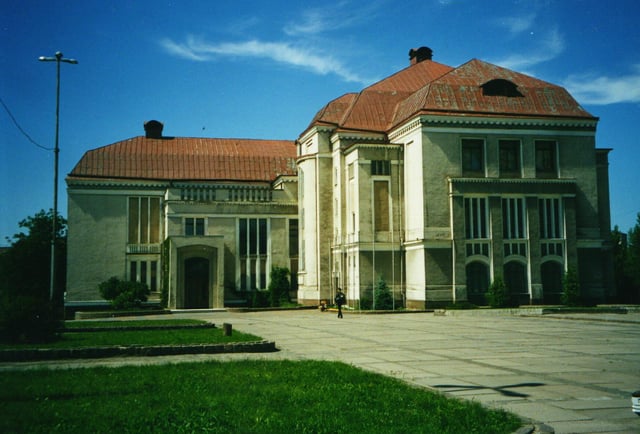
Museum of History and Arts, formerly Königsberg's Stadthalle
Kaliningrad has many museums. A few examples are the Immanuel Kant museum on the Kneiphof island, the Regional Museum of History and Arts, which has parts of Königsberg Castle's Prussia Museum of local archaeological findings, and the Kaliningrad Amber Museum, which is situated in the Dohna Tower near the Rossgarten Gate. The city is also home to the Kaliningrad State Art Gallery, established in 1988, that is developing as a contemporary art museum.[24] The Museum of the World's Oceans is located on the former research vessel Wityaz on the shore of the Pregel river. The museum displays the newest technologies on sea research and also shows the diversity of the flora and fauna of the world's oceans. An anchored Foxtrot-class submarine next to the museum, the B-413, hosts an exhibit about the Russian submarine fleet.
Theatre
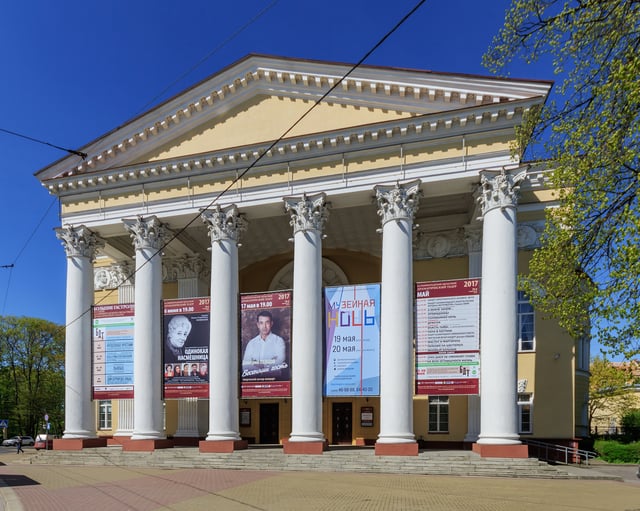
Kaliningrad Regional Drama Theater
The Kaliningrad Philharmonic Orchestra is accommodated in the former Catholic Church of the Holy Family of Königsberg, built in 1907. The church escaped major damage in World War II and was refurbished afterwards. The building, which has noted acoustics, functions as an organ hall since re-opening in 1980.
The Kaliningrad Regional Drama Theatre is located in the former Königsberg Neues Schauspielhaus, which was opened in 1910. The building was rebuilt after the war using earlier plans for the theatre and opened in 1960. The colonnade in front of the entrance was modelled after the Bolshoi Theatre in Moscow.
The regionally notable Kaliningrad Puppet Theatre has had its seat since 1975 in the Queen Louise Remembrance Church. This neo-romantic church, designed by architect Fritz Heitmann, was built in 1901.
Architecture
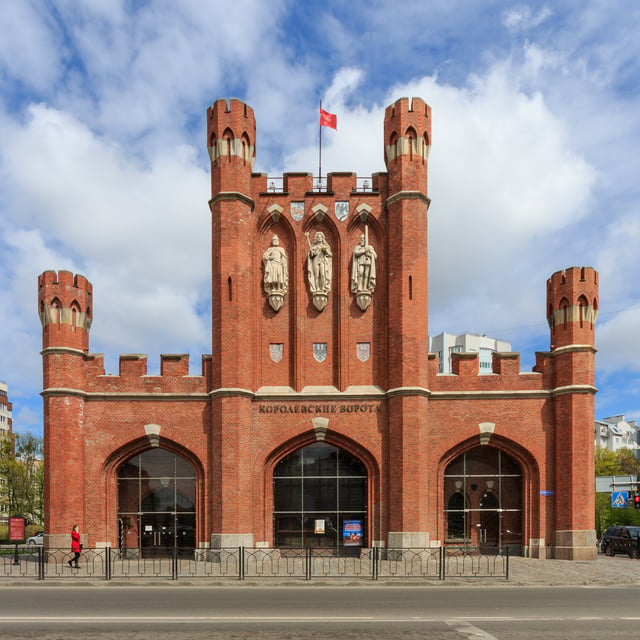
King's Gate
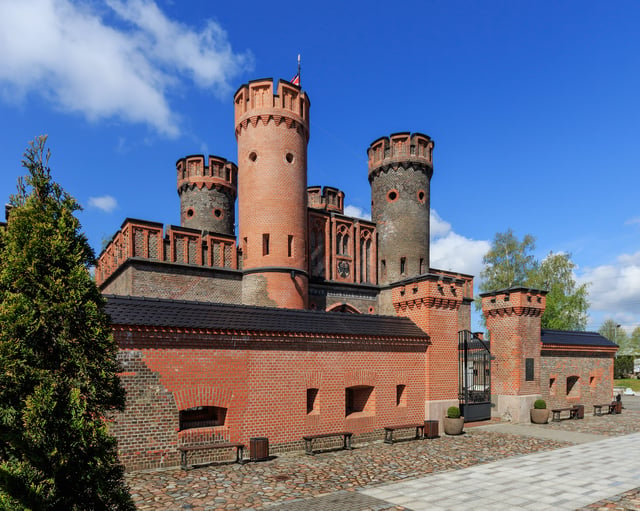
Friedrichsburg Gate
The pre-war city center (Altstadt and Kneiphof) currently consists of parks, broad avenues, a square on the site of the former Königsberg Castle, and two buildings: the House of Soviets ("Dom Sovyetov"), roughly on the site of the former castle, and the restored Königsberg Cathedral on the Kneiphof island (now "Kant island"). Immanuel Kant's grave is situated next to the cathedral. Many German-era buildings in the historic city centre have been preserved and even rebuilt, including the reconstruction of the Königsberg Synagogue. The new city centre is concentrated around Victory Square. The Cathedral of Christ the Savior, consecrated in 2005, is located on that square.
The oldest building in Kaliningrad is the Juditten Church (built before 1288). Also worth seeing are the former Stock Exchange, the surviving churches, and the remaining city gates. In counter-clockwise order these gates are: the Sackheim Gate, King's Gate, Rossgarten Gate, Attack Gate (German: Ausfallstor, or Sally Port), Railway Gate (Eisenbahntor), Brandenburg Gate, and Friedland Gate (Friedländer Tor (Kaliningrad)). Apart from the already mentioned Dohna Tower, which houses the Amber Museum, the Wrangel Tower also remains as a reminder of the former Königsberg city walls. Only the gate of the former Fort Friedrichsburg remains.
Monuments
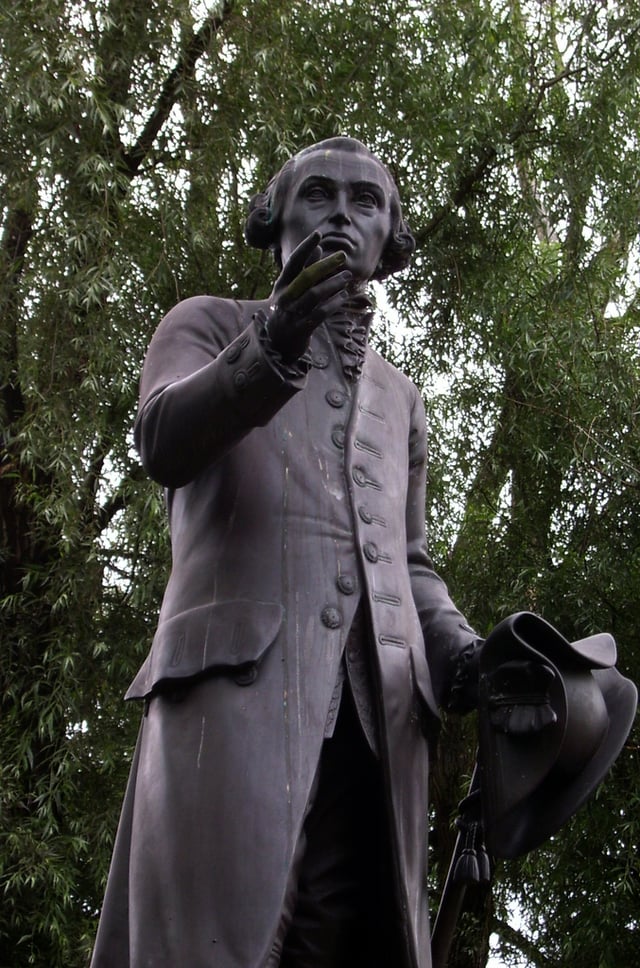
Recast Immanuel Kant statue
Notable monuments include the statue of Immanuel Kant in front of the Immanuel Kant State University of Russia. The statue was made by notable sculptor Christian Daniel Rauch and unveiled in 1864. The statue was destroyed in 1945, but was remoulded in 1992 on the initiative of Marion Dönhoff, a native East Prussian who became prominent in the West. Also worth seeing is the Cosmonaut monument, which honours the Kaliningrad cosmonauts Alexei Leonov, Yuri Romanenko and Aleksandr Viktorenko. Other statues and monuments include the statue for Duke Albert, the statue for Friedrich Schiller, the statue for Tsar Peter the Great, Vladimir Vysotsky, the "Mother Russia" monument, and the Monument for the 1200 Guardsmen, remembering the Battle of Königsberg.
Parks
Kaliningrad is a very "green" city with a large number of parks and areas with lots of trees and lawns. Parks range from tiny city squares to massive parks.
Youth Recreation Park is one of the well known and popular parks in the city. The park was established in the '20s-'30s in the English style. It reopened its doors post war and was popular among citizens in the '80s-'90s with its beautiful boat house and tennis courts, as well as merry-go-rounds.[25] The park had a massive reconstruction in 2004 adding to the park a cafe, carting, and various modern entertainments. It is located in the quiet area of the city, in Leningradsky area, and is connected to the Lower Pond. Youth Recreation Park provides entertainment for all age groups. There is also Interpersonal Communications Development Central located in the park. Its beautiful building became a popular backdrop for wedding pictures.
The Kaliningrad Zoo was opened as the Königsberg Zoo in 1896. The collection, which extends over 16.5 ha, comprises 315 species with a total of 2,264 individual animals (as of 2005). The Kaliningrad Zoo is also an arboretum.
Ponds
Centrally located in the city is Lower Pond, an artificial lake. Lower Pond is surrounded by a promenade and is an area for recreation especially in summer. North of the Lower Pond is the larger Upper Pond in northern Kaliningrad.
Bridges
Leonhard Euler's 1736 paper on the puzzle of the Seven Bridges of Königsberg was a seminal work in the fields of graph theory and topology. Only two of the structures from his era survive.
Kaliningrad Arena
In 2018, a new stadium, Kaliningrad Arena, was built on the Oktyabsrky Island, near the embankment of the Staraya Pregolya River. The stadium has a seating capacity of 35,000.
Geography
Kaliningrad is at the mouth of the navigable Pregolya River, which empties into the Vistula Lagoon, an inlet of the Baltic Sea.
Sea vessels can access Gdańsk Bay/Bay of Danzig and the Baltic Sea by way of the Vistula Lagoon and the Strait of Baltiysk.
Until around 1900, ships drawing more than 2 meters (6 ft 7 in) of water could not pass the bar and come into town; larger vessels had to anchor at Pillau (now Baltiysk), where cargo was transferred to smaller vessels. In 1901, a ship canal between Königsberg and Pillau, completed at a cost of 13 million German marks, enabled vessels of a 6.5 meters (21 ft) draught to moor alongside the town (see also Ports of the Baltic Sea).
Climate

This photograph from the ISS captures the two large lagoons to the north and south of Kaliningrad. The dark blue features are land. (From an astronaut's perspective in low-Earth orbit, land surfaces usually appear brighter than water. But in this image, reflected sunlight, or sunglint, inverts this pattern.)
Kaliningrad has a humid continental climate (Dfb or Cfb, depending on the isotherm chosen for class C climates), with cold, cloudy, (though moderate compared to most of Russia) winters and mild summers with frequent showers and thunderstorms. Average temperatures range from −1.5 to +18.1 °C (29.3 to 64.6 °F) and rainfall varies from 36.0 millimeters (1.42 in)/month to 97.0 millimeters (3.82 in)/month. In general, it has maritime climate influences and therefore damp, variable and mild, with vast temperature differences between July and January.
The seasons are clearly differentiated. Spring starts in March and is initially cold and windy, later becoming pleasantly warm and often very sunny. Summer, which begins in June, is predominantly warm but hot at times (with temperature reaching as high as +30–+35 °C (86–95 °F) at least once per year) with plenty of sunshine interspersed with heavy rain. The average annual hours of sunshine for Kaliningrad are 1700, similar to other northern cities. Autumn comes in September and is at first warm and usually sunny, turning cold, damp and foggy in November. Winter includes periods of snow. January and February are the coldest months with the temperature sometimes dropping as low as −15 °C (5 °F).
| Climate data for Kaliningrad | |||||||||||||
|---|---|---|---|---|---|---|---|---|---|---|---|---|---|
| Month | Jan | Feb | Mar | Apr | May | Jun | Jul | Aug | Sep | Oct | Nov | Dec | Year |
| Record high °C (°F) | 12.7 (54.9) | 15.6 (60.1) | 23.0 (73.4) | 28.5 (83.3) | 30.6 (87.1) | 33.5 (92.3) | 36.3 (97.3) | 36.5 (97.7) | 33.8 (92.8) | 26.4 (79.5) | 19.4 (66.9) | 13.3 (55.9) | 36.5 (97.7) |
| Average high °C (°F) | 0.7 (33.3) | 1.5 (34.7) | 5.6 (42.1) | 12.3 (54.1) | 18.0 (64.4) | 20.5 (68.9) | 23.0 (73.4) | 22.6 (72.7) | 17.6 (63.7) | 12.1 (53.8) | 5.6 (42.1) | 1.9 (35.4) | 11.8 (53.2) |
| Daily mean °C (°F) | −1.5 (29.3) | −1.1 (30.0) | 2.0 (35.6) | 7.3 (45.1) | 12.5 (54.5) | 15.5 (59.9) | 18.1 (64.6) | 17.6 (63.7) | 13.1 (55.6) | 8.4 (47.1) | 3.3 (37.9) | −0.3 (31.5) | 7.9 (46.2) |
| Average low °C (°F) | −3.9 (25.0) | −3.6 (25.5) | −1.1 (30.0) | 2.9 (37.2) | 7.4 (45.3) | 10.9 (51.6) | 13.6 (56.5) | 13.1 (55.6) | 9.2 (48.6) | 5.2 (41.4) | 1.1 (34.0) | −2.5 (27.5) | 4.4 (39.9) |
| Record low °C (°F) | −32.5 (−26.5) | −33.3 (−27.9) | −21.7 (−7.1) | −5.8 (21.6) | −3.1 (26.4) | 0.7 (33.3) | 4.5 (40.1) | 1.6 (34.9) | −2.0 (28.4) | −11.2 (11.8) | −18.7 (−1.7) | −25.6 (−14.1) | −33.3 (−27.9) |
| Average precipitation mm (inches) | 68 (2.7) | 49 (1.9) | 52 (2.0) | 36 (1.4) | 54 (2.1) | 79 (3.1) | 77 (3.0) | 97 (3.8) | 74 (2.9) | 82 (3.2) | 83 (3.3) | 73 (2.9) | 824 (32.4) |
| Average rainy days | 14 | 13 | 14 | 14 | 14 | 16 | 15 | 16 | 17 | 18 | 18 | 16 | 185 |
| Average snowy days | 15 | 15 | 10 | 3 | 0.1 | 0 | 0 | 0 | 0 | 1 | 7 | 13 | 64 |
| Average relative humidity (%) | 85 | 83 | 78 | 72 | 71 | 74 | 75 | 77 | 81 | 83 | 86 | 87 | 79 |
| Mean monthly sunshine hours | 35 | 61 | 120 | 171 | 253 | 264 | 257 | 228 | 158 | 96 | 38 | 26 | 1,707 |
| Source #1: Pogoda.ru.net[26] | |||||||||||||
| Source #2: NOAA (sun 1961–1990)[27] | |||||||||||||
Culture
Education
An important education centre in Kaliningrad is the Immanuel Kant Baltic Federal University. It is the successor to the Albertina, which was the old university of Königsberg founded in 1544, and whose faculty included noted scholars as Abraomas Kulvietis, Stanislovas Rapalionis, Immanuel Kant, and Jan Mikulicz-Radecki.
Music
The modern city of Kaliningrad is home to the Kaliningrad Regional Philharmonic and Symphony Orchestra, the Lik male chamber choir and the Garmonika Russian music ensemble,[28] as well as the Kaliningrad Chamber Orchestra.[29]
Cuisine
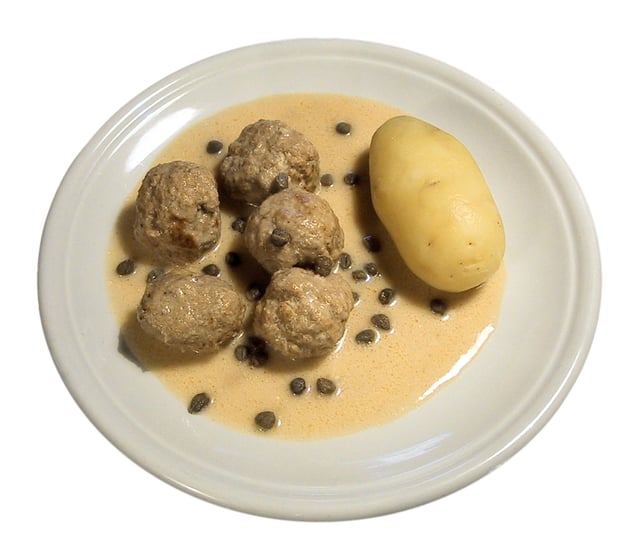
Königsberger Klopse are a Prussian specialty of meatballs in a white sauce with capers that can be found in many restaurants in Kaliningrad.
Kaliningrad has its own vodka and beer brands, Stari Königsberg and Ostmark respectively. Since the early 1990s many new restaurants have opened in the city. These restaurants offer culinary specialities of former East Prussia, like Königsberger Klopse, but also many fish and salad dishes, Italian pizza and sushi, which is as popular in Kaliningrad as in the rest of Russia. Königsberger Fleck, a bovine tripe soup and yet another culinary specialty from former Königsberg, no longer belongs to the culinary culture of Kaliningrad.
The people of Kaliningrad generally imported their respective culinary traditions to the region when they settled in the area after 1945. Borshch and okroshka may be served as in the rest of Russia. Many Italian and Asian restaurants (or fusions of both traditions) are in operation all over the city. Pizza and sushi are among the most popular dishes today. Fast food is widely available from various chains, including those of foreign origin. Shawarma is also gaining considerable prominence.
Transportation
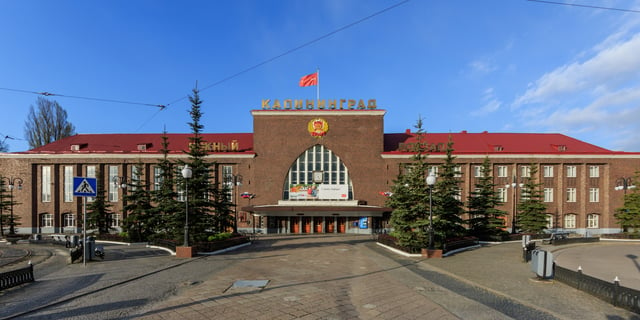
Kaliningrad Railway station
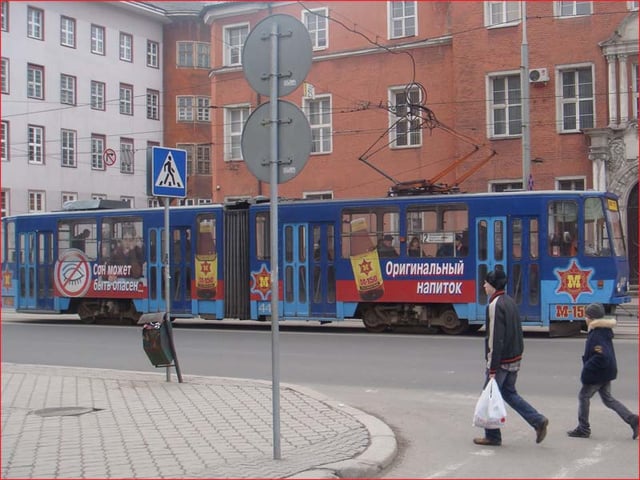
Tramway in Kaliningrad
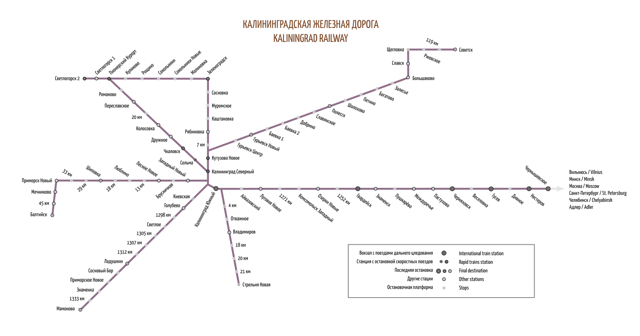
Rail network in Kaliningrad Oblast
Khrabrovo Airport, 24 kilometers (15 mi) north of Kaliningrad, has scheduled and charter services to several destinations throughout Europe. There is the smaller Kaliningrad Devau Airport for general aviation. Kaliningrad is also home to Kaliningrad Chkalovsk naval air base.
In Baltiysk, one can take a ferry to St. Petersburg, Stockholm, Copenhagen, Riga, and Kiel.
Kaliningrad's international railway station is Kaliningrad Juzhnyi, which in German times was known as Königsberg Hauptbahnhof. Trains depart in the directions of Moscow, Saint Petersburg, Adler and Chelyabinsk. A unique feature of the Kaliningrad railway is that some tracks in the direction of Poland and Berlin have a standard gauge track parallel to the Russian broad gauge of 1520 mm, used mostly for strategic reasons during the Cold War and nowadays for goods traffic. Platform number 6 at the Passazhirsky station can be reached on standard gauge over the former Ostbahn main line from Elbing (Elbląg) making passenger traffic from Poland possible, although there are no direct trains as of 2019.
Regional trains also depart from Kaliningrad-North, the former Königsberg Nordbahnhof, which is situated on Victory Square, the current city center. Trains depart to Zelenogradsk and Svetlogorsk several times a day. There are also dayly connections to other towns in the region, like Sovetsk, Baltijsk, Mamonovo, Chernyakhovsk. The lines to the Zelenogradsk and Svetlogorsk have been electrified. Many local pre-war lines have been broken up or are no longer in use, because the new border with Poland disrupted the former traffic flows.
In 1881, the Königsberg tramway system was opened, and it still functions to this day. In 1975, a trolleybus system was also introduced.
Economy
In 1996, Kaliningrad was designated a Special Economic Zone, referred to as FEZ Yantar. Manufacturers based there get tax and customs duty breaks on the goods they send to other parts of Russia. Although corruption was an early deterrent, that policy means the region is now a manufacturing hub. One in three televisions in Russia are made in Kaliningrad (including Ericsson brand by Telebalt Ltd. and Polar by an eponymous firm located in the city of Chernyakhovsk) and it is home to Cadillac and BMW related car plants (produced by Avtotor). Currently, Kaliningrad's major industries are manufacturing, shipping, fishing and amber products. In 2006, Moscow declared it would turn the region into "the Russian Hong Kong".[30]
The European Commission provides funds for business projects under its special programme for Kaliningrad. With an average GDP growth of more than 10% per year for three years to 2007, Kaliningrad grew faster than any other region in Russia, even outstripping the success of its EU neighbours. By early 2015, the BBC reported the region's trade with the countries of the EU was increasing, with improved economic growth and industrial output.[31]
Military
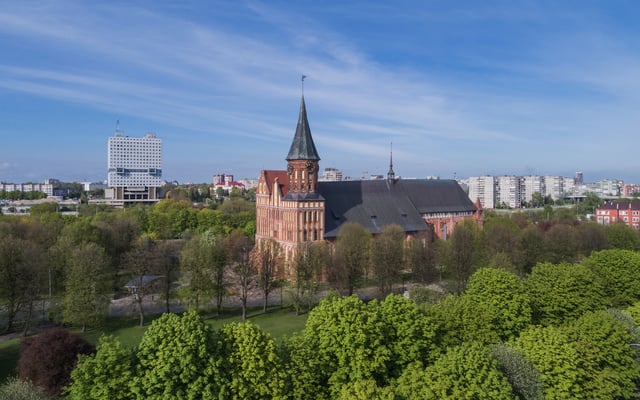
Königsberg Cathedral on Kneiphof island
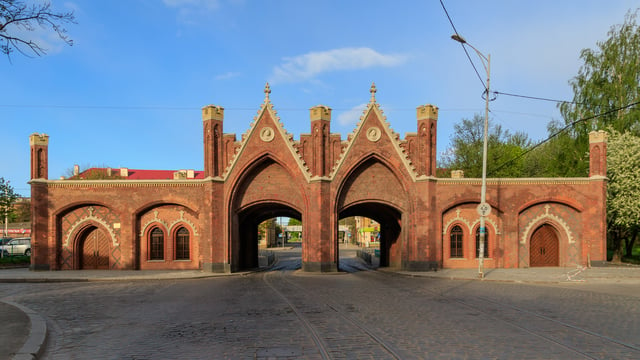
Brandenburg Gate
Kaliningrad Oblast used to be the most heavily militarized area of what is now the Russian Federation, and the density of military infrastructure was the highest in Europe. It was the headquarters of the former Soviet Baltic Military District. Kaliningrad also functions as the headquarters of Russia's Baltic Fleet, ringed by Chernyakhovsk (air base), Donskoye (air base) and Kaliningrad Chkalovsk (naval air base).
Soviet era
Access and control to the Baltic Sea was imperative because of Soviet perceptions that this meant that the hegemonic power had "influence on European and global affairs". Russia had replaced Sweden as the hegemon since the 18th century, but during the late 19th and early 20th century it was increasingly ousted by Germany's growing naval power.[32] At any point in time during the Soviet era, there would be at least 100,000 troops stationed in Kaliningrad (though there are some estimates that run up to 300,000). Therefore, the population of the city was fluid and almost always temporary. Many military officers and their families would refer to the Kaliningrad Oblast as "the West". The Soviet Union also kept nuclear weapons for use in case a war occurred.[33]
Demographics

Local residents in Kaliningrad at "Immortal regiment", carrying portraits of their ancestors who fought in World War II

The blessing of the Easter baskets in Kaliningrad
The original German population fled or was expelled at the end of World War II when the territory was annexed by the Soviet Union. In October 1945, only about 5,000 Soviet civilians lived in the territory.[34] Between October 1947 and October 1948, about 100,000 Germans were forcibly moved to Germany.[35] By 1948, about 400,000 Soviet civilians arrived in the Oblast.[34]
Today the overwhelming majority Kaliningrad's residents are of Russian ethnicity settled after 1945. A minority of the population are from other Slavic people. Kaliningrad today is home to communities of Ukrainian, Belarusian, Tatar, German, Armenian, Polish, and Lithuanian.
Ethnic composition, Russian 2010 census:
Poles in Kaliningrad
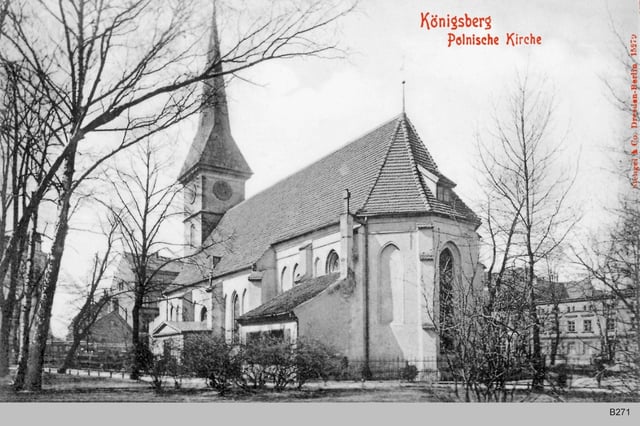
The Polish church in Steindamm was the oldest church of Konigsberg.
In the 1940s and 1950s the Soviets resettled Poles from Belarus, the Baltic states, Ukraine, and Russia to Kaliningrad.[36] According to Wacław Podbereski after the Second World War and the takeover of the administration in these areas by the Soviets, the development of the Polish element in this region effectively ceased.[37] The oldest church in Königsberg was the Polish church of St. Nicholas, which had been founded with the city in 1255 in the historic district of Steindamm. It had Polish-language services until 1901.[37] Change came with the disintegration of the Soviet Union, due mainly to pastoral activities that began the repopulation of the Poles in Russia. The first steps were made by a Polish priest from Grodno (Hrodna), Jerzy Steckiewicz.[38]
The "Polish Cultural Community in Kaliningrad" operates as the main Polish organization among Kaliningrad's Polonia, one of six such Polish organizations within Kaliningrad Oblast.[38][39] Wspolnota Polska estimates that it is likely there are between 15,000 and 20,000 Poles living in the entire oblast. The "Polish Cultural Community in Kaliningrad" organizes poetry contests and is the publisher of the local Polish-language newspaper The Voice from the Pregel.[39] The whole Kaliningrad Oblast has witnessed an increase in Polish cultural activity since the fall of the Soviet Union, partly due to the immigration of Polish families from Kazakhstan, who had been deported by Stalin during the Soviet invasion of Poland in 1939.[36]
Sports
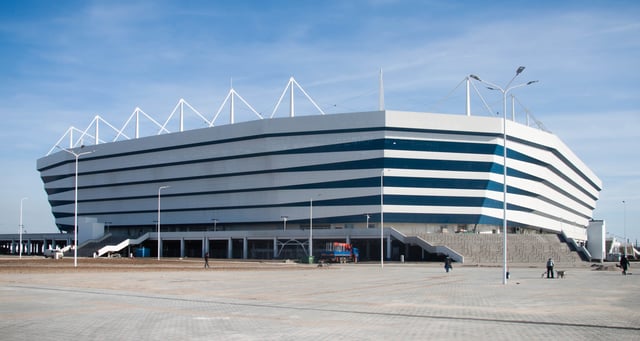
The Kaliningrad Stadium hosted the 2018 FIFA World Cup games
Kaliningrad is home to the football club FC Baltika Kaliningrad, which plays in the Football Championship of the National League (formerly Russian First Division). It played in the Russian Premier League for 3 seasons between 1996 and 1998.
Kaliningrad was the host of some games in the 2018 FIFA World Cup.
Notable people
Sergey Snegov (1910–1994), science fiction writer
Viktor Patsayev (1933–1971)
Alexei Leonov (born 1934), first person to walk in space
Yury Romanenko (born 1944)
Alexander Viktorenko (born 1947)
Oleg Gazmanov (born 1951), singer
Sergei Beloglazov (born 1956) Olympic wrestler
Lyudmila Putina (born 1958), ex-wife of Vladimir Putin, First Lady of Russia
Alexander Volkov (born 1967), tennis player
Dmitry Lapikov (born 1982), Olympic weightlifter
Tvangeste, symphonic black metal band
Maksim Zuyev, journalist and activist
International relations
Diplomatic missions
In 2004, Germany opened a consulate general in Kaliningrad[40]. This consulate allows Kaliningrad residents to get Schengen visas without having to travel to Moscow. An agreement between Gerhard Schröder, Chancellor of Germany, and President of Russia Vladimir Putin established the consulate in light of Lithuania and Poland, which surround Kaliningrad, joining the EU. Russian concerns with Germany wanting the former Königsberg back had stifled earlier plans for a German consulate.[41][42][43]
Small border traffic law
Poland and the Russian Federation have an arrangement whereby residents of Kaliningrad and the Polish cities of Olsztyn, Elbląg and Gdańsk may obtain special cards permitting repeated travel between the two countries, crossing the Polish–Russian border. As of July 2013, Poland had issued 100,000 of the cards. That year, Russians visiting Poland to shop at the Biedronka and Lidl supermarkets featured in songs by musical group Parovoz.[44]
Twin towns and sister cities
|
See also
Battle of Königsberg
Heart of the City (Kaliningrad)
Kaliningrad (Königsberg) dispute
Radio Königsberg
Seven Bridges of Königsberg




